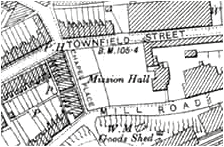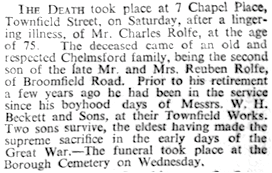Frederick Charles Guiver Rolfe followed his father’s profession of wood turner. He served initially as a Territorial soldier and was killed in action in October 1916 during the latter stages of the Battle of the Somme. His home was in Chapel Place.
ROLFE, FREDERICK CHARLES GUIVER,
Private, 11th (Service) Battalion, Royal Fusiliers (formerly of the Essex Regiment)
Frederick’s death was announced by his family in the Essex Weekly News on 24th November 1916:
“Rolfe. - Killed in action on November 4th, Lance-Corpl. Fred, Rolfe, the dearly-loved eldest son Charles and Alice Rolfe, 7 Chapel-place, Chelmsford, aged 27 years.
We cannot tell what pains he bore - We never saw him die. We only know he passed away. Without a last good-bye.
From his sorrowing Father, Mother, Brothers and Rosie.”
On 24th November 1916 and 1st December 1916 the Essex Weekly News announced:
“Pte. Frederick C. Rolfe, Royal Fusiliers, formerly in the Essex Regt., killed in action on Nov. 4, was the eldest son of Mr. and Mrs. C. Rolfe, of Chapel Place, Chelmsford. He was formerly a bugler in the 5th Essex Territorials. A brother, who is serving with the Essex Regt., has been wounded.”
On 8th December 1916 the Essex County Chronicle reported:
“Pt. Frederick C. Rolfe, Royal Fusiliers, formerly in the Essex Regt., eldest son of Mr. and Mrs. C. Rolfe, of Chapel Place, Chelmsford, was killed in action on Nov. 4. He was formerly a bugler in the 5th Essex. A brother, serving with the Essex Regt., has been wounded.”
Frederick has no known grave and is commemorated on the Thiepval Memorial, near Albert, Somme, France, on the Civic Centre Memorial, Chelmsford, by the Chelmsford Parish Great War Memorial in Chelmsford Cathedral and on the Hoffmann Manufacturing Company’s War Memorial at Chelmsford Cathedral. He was entitled to the Victory and British War medals.
Frederick is though to have been recorded twice on the Civic Centre Memorial, Chelmsford; once as ‘Pte. F. C. G. Rolfe’ of the Essex Regiment and once as ‘L-Cpl. F C. Rolfe’ of the Royal Fusiliers.
The 1918 register of electors listed Frederick’s parents and brother Leonard at 7 Chapel Place. His mother died in 1921. His father died in 1937. aged 75. Chapel Place was demolished after being severely damaged in an air raid on Chelmsford in 1943.
131230

Frederick was born in Chelmsford on 4th May 1889, the eldest son of the wood turner Charles Rolfe and Alice Rolfe (nee Guiver). He was christened at St. Mary’s Church (later the Cathedral), Chelmsford on 8th June 1889 - at that time his father was a woodturner living at 10 Compasses Row, off Broomfield Road, Chelmsford.
His father had been born in 1862 in Chelmsford; his mother in Ramsden in 1862. His parents had married on 25th June 1888 at St. Mary Magdalene's Church in Great Burstead. At that time Frederick’s father was a 26 year-old woodturner living in Chelmsford; his bride, a year younger, lived in
Great Burstead.
Frederick’s siblings were Leonard Frank Rolfe and Stanley Robert Rolfe, both born in Chelmsford, on 25th December 1891 and 6th March 1896 respectively. They both died in 1973.
The 1891 census found one year-old Frederick living with his parents at 10 Coopers Row, Chelmsford. His father was employed as a wood turner. The family were still at the premises at the 1901 census, with Frederick accompanied by two younger siblings and his parents. His father remained a wood turner.
By 1910 the Rolfe family had moved to 7 Chapel Place, Chelmsford, a short terrace of houses that stood between Townfield Street and Mill Lane, opposite the White Horse pub. The 1911 census found the family there - Frederick was employed as a wood turner; his father was also a wood turner at a brush-maker’s; his brother Leonard was a lift driver at Hoffmann’s; and brother Stanley was a iron turner at an electrical engineer’s. Frederick is known to have worked at Hoffmann’s bearings factory in Chelmsford prior to joining the army.
Frederick enlisted at Chelmsford and served as Private 40304 in the Essex Regiment. He was a bugler in the regiment’s 5th Battalion, a Territorial unit, based in Chelmsford. Later he served as Private 60321 in the 11th (Service) Battalion of the Royal Fusiliers. The battalion was part of the New Armies and had been formed at Hounslow, Middlesex in September 1914 and gone to France the following summer, attached to 54th Brigade of the 18th (Eastern) Division.
During the summer and autumn of 1916 Frederick’s battalion participated in the Battle of the Somme. On 1st July 1916, the battle’s opening day, it made a successful attack from north of Carnoy capturing Pommiers Redoubt near Montauban. On 26th September 1916 it helped capture Thiepval. On 25th October 1916 Frederick’s battalion was relieved from trenches by the 12th Middlesex Regiment and withdrew to billets in Albert. Over the next few days they carried out training and other activities before returning to the trenches on 3rd November 1916 to relieve the 8th Norfolk Regiment in sector R23. Frederick was killed in action the following day. The war diary’s entry for the day was very sparse:
“Trenches - 4/11/16 - Weather very bad. Artillery very active on both sides.”
Two days later Frederick’s battalion was relieved by the 12th Middlesex Regiment and returned to Albert. The three day tour of duty had seen the following casualties for the battalion including Frederick: 15 other ranks wounded, 7 other ranks killed, 1 other rank missing, 1 other rank shell-shock, 1 other rank injured back.


